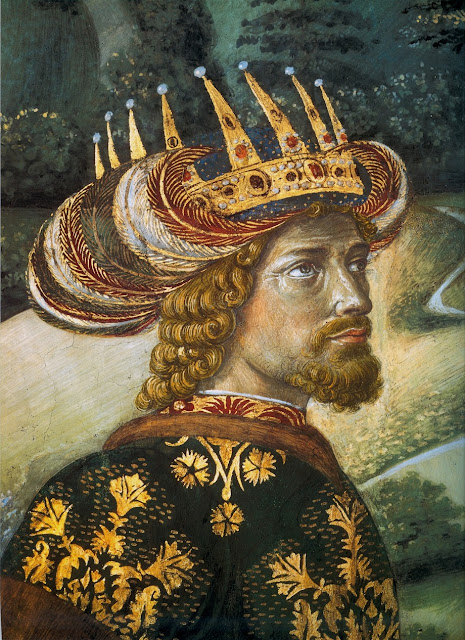The biblical Magi, also referred to as the Wise Men or Kings, were – in the Gospel of Matthew – distinguished foreigners who visited Jesus after his birth, bearing gifts of gold, frankincense & myrrh. Matthew is the only of the 4 canonical gospels to mention the Magi. Matthew reports that they came "from the east" to worship the "king of the Jews." The gospel does not mention the number of Magi, but most western Christian denominations have traditionally assumed them to have been 3 in number, based on the statement that they brought 3 gifts. In Eastern Christianity, especially the Syriac churches, the Magi often number 12. Their identification as kings in later Christian writings is probably linked to the anticipatory Psalm 72:11, "May all kings fall down before him."
The phrase "from the east" (ἀπὸ ἀνατολῶν, apo anatolon), more literally "from the rising [of the sun]," is the only information Matthew provides about the region from which they came. The Parthian Empire, centered in Persia, occupied virtually all of the land east of Judea & Syria (except for the deserts of Arabia to the southeast). Though the empire was tolerant of other religions, its dominant religion was Zoroastrianism. Although Matthew's account does not cite the motivation for their journey, the Syriac Infancy Gospel provides some clarity by stating explicitly in the 3rd chapter that they were pursuing a prophecy from their prophet, Zoradascht (Zoroaster).
There is an Armenian tradition identifying the "Magi of Bethlehem" as Balthasar of Arabia, Melchior of Persia, & Gaspar of India. Historian John of Hildesheim relates a tradition in the ancient silk road city of Taxila (near Islamabad in Pakistan) that one of the Magi passed through the city on the way to Bethlehem. The Silk Road was a network of trade routes connecting China & the Far East with the Middle East & Europe. Established when the Han Dynasty in China officially opened trade with the West in 130 B.C., the Silk Road routes remained in use until 1453 A.D., when the Ottoman Empire boycotted trade with China & closed them.
Sebastian Brock, a historian of Christianity, said: "It was no doubt among converts from Zoroastrianism that… certain legends were developed around the Magi of the Gospels." Central Asian Christian king, Prester John's Mongol descendants were sought as allies against the Muslims by contemporary European monarchs & popes.
Sempad the Constable of Armenia visited the Mongol court in Karakorum in 1247–1250 & in 1254. He wrote a letter to Henry I King of Cyprus & Queen Stephanie (Sempad’s sister) in 1243, in which he said: “Tanchat [Tangut, or Western Xia], which is the land from whence came the Three Kings to Bethlehem to worship the Lord Jesus which was born. & know that the power of Christ has been, & is, so great, that the people of that land are Christians; & the whole land of Chata [Khitai, or Kara-Khitai] believes those Three Kings. I have myself been in their churches & have seen pictures of Jesus Christ & the Three Kings, one offering gold, the second frankincense, & the third myrrh. & it is through those Three Kings that they believe in Christ, & that the Chan & his people have now become Christians”
Marco Polo claimed that he was shown the 3 tombs of the Magi at Saveh south of Tehran in the 1270s: In Persia is the city of Saba, from which the Three Magi set out when they went to worship Jesus Christ; & in this city they are buried, in 3 very large & beautiful monuments, side by side. & above them there is a square building, carefully kept. The bodies are still entire, with the hair & beard remaining. (Marco Polo, Polo, Marco, The Book of the Million, book I, chapter 13)



,+Adoration+of+the+Magi,+ca.+1514..jpg)
















%20Adoration%20of%20the%20Magi.jpg)

%2BJourney%2Bof%2Bthe%2BMagi%2B1435.jpg)





